Thunderbolt on Windows Part 2: Intel's DZ77RE-K75 & ASUS' P8Z77-V Premium
by Anand Lal Shimpi on June 3, 2012 2:08 AM EST- Posted in
- Motherboards
- CPUs
- Intel
- Asus
- Thunderbolt
- Ivy Bridge
- Chipsets
Quad-core mobile Sandy Bridge, 2.5" SSDs and Thunderbolt together have allowed me to use a notebook as my primary work machine. I get all of the portability benefits of a notebook, but with almost none of the performance sacrifices. The only thing I'm really missing is a good, external discrete GPU solution but that's a problem being worked on either via Thunderbolt link aggregation or the second revision of the Thunderbolt spec.

Despite what it's done for me, Thunderbolt has to be one of the most strangely handled interface specs of recent history. Intel engineered the spec, but Apple helped with a lot of the connector and cable design and as a result received a year long exclusive on Thunderbolt. Since its introduction, Thunderbolt has received a reasonable amount of support on the Mac platform. Apple even builds a display designed exclusively for use with Thunderbolt equipped Macs. Companies like Promise, Seagate, Western Digital, LaCie and Elgato are all shipping Mac compatible Thunderbolt devices as well.
With the exclusivity agreement over, Intel's partners in the Windows PC space are allowed to ship Thunderbolt enabled motherboards and systems. Making things even more bizarre is the fact that all Thunderbolt devices have to go through Intel's certification program if they are to be approved for use under Windows. Technically only Promise's Pegasus is certified (or about to be certified) for use under Windows, despite the fact that all of these Thunderbolt devices have been available for use under Windows via Boot Camp on Macs.
The complications extend even further when you realize that Apple's own products aren't certified for use under Windows. The Thunderbolt Display is only officially supported under OS X and I don't see Apple being incredibly motivated to work on Windows certification for it. Interfaces like USB are great because you can generally count on anything that physically fits in the port just working. With Thunderbolt on Windows we now have a situation where you can't assume the same.
We got the first look at a Thunderbolt equipped PC motherboard with MSI's Z77A-GD80 a couple of weeks ago. The interface worked but was not without its quirks. To be totally fair however, the Thunderbolt experience under OS X isn't perfectly problem free either. It turns out that MSI sampled that motherboard prior to making it through the motherboard certification process. Since then, the motherboard has made it through cert and has an updated BIOS that should improve its behavior.
Both Intel and ASUS sent us their latest, fully certified, Thunderbolt equipped motherboards for another look at how the interface works under Windows. With motherboards available today, it's now time to take a complete look at what Thunderbolt is like outside of the Apple ecosystem.
The Motherboards
ASUS sent its P8Z77-V Premium motherboard with Thunderbolt support, while Intel sent its DZ77RE-75K Thunderbolt board. Only the ASUS board is publicly available and is priced at $450. ASUS will have a more affordable SKU with integrated Thunderbolt available in the future: the P8Z77-V Pro/Thunderbolt, which should be priced below $300. Other ASUS boards will be upgradeable to support Thunderbolt via an on-board header + add-in card.
The Intel board starts at $262 and goes as high as $278 depending on the in-box configuration (both include WiFi/BT dongles, while the $278 version comes with front panel USB 3.0 support).
Both boards branch the Thunderbolt controller off of the Z77 PCH, borrowing four PCIe 2.0 x1 lanes. Given how full featured these motherboards are, PCIe switches are employed to allow the use of all the remaining PCIe devices connected to the PCH.
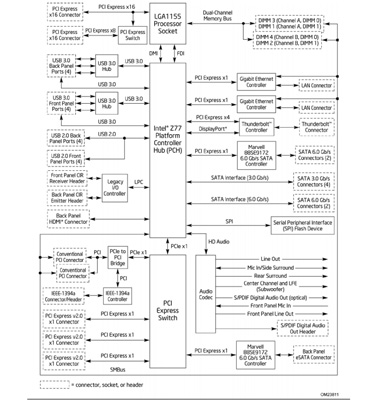
Intel's Z77 Thunderbolt Motherboard Block Diagram
ASUS goes one step further and includes a PCIe 3.0 switch to enable quad-CF/SLI support despite the limited number (16) of PCIe lanes Intel's LGA-1155 CPUs provide. ASUS' board features all the bells and whistles including a 32GB Marvell based Liteon mSATA SSD:
The Thunderbolt port on both boards can serve as either a Thunderbolt port or a DisplayPort output, similar to the behavior on a Thunderbolt Mac. Discrete GPUs are supported through the on-board Thunderbolt/DisplayPort output, provided you have Lucid's Virtu software installed.
As Thunderbolt carries more bandwidth than USB 3.0, trace routing is very important to achieving max performance. You'll notice that on all Thunderbolt boards we've tested thus far, the Cactus Ridge controller and Thunderbolt port are very close to one another. The spec for max trace length between the Thunderbolt controller and port is two inches, compared to up to 10 inches for Intel's USB 3.0 controller.
ASUS tells us that in order to reduce crosstalk it spaced Thunderbolt traces 1.5x wider than traces for USB 3.0 on its boards. Finally, all Thunderbolt traces are on the same PCB layer and don't feature any sharp angles in their route—only gradual arcs, which further improves performance. There's an impressive amount of engineering that has to go into bringing Thunderbolt support to a motherboard.
BIOS/UEFI support for Thunderbolt appears to be identical across all of the third party board makers. ASUS' Thunderbolt options look identical to MSI's for example:
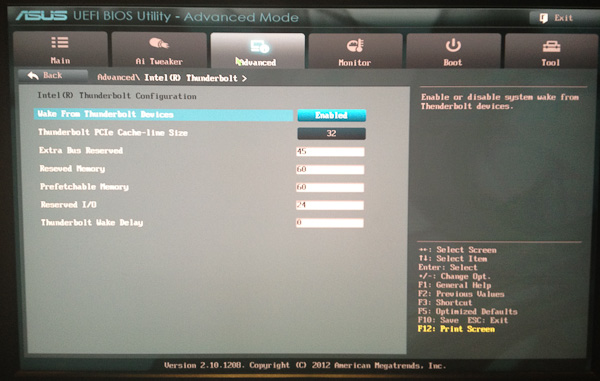
Interestingly enough, Intel doesn't actually expose any of the specific Thunderbolt settings. The Intel board just lets you enable/disable the interface itself:
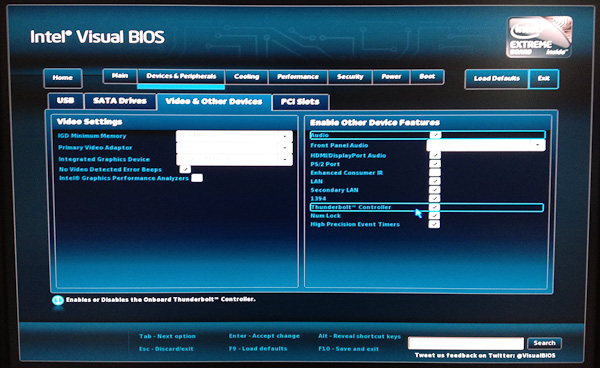


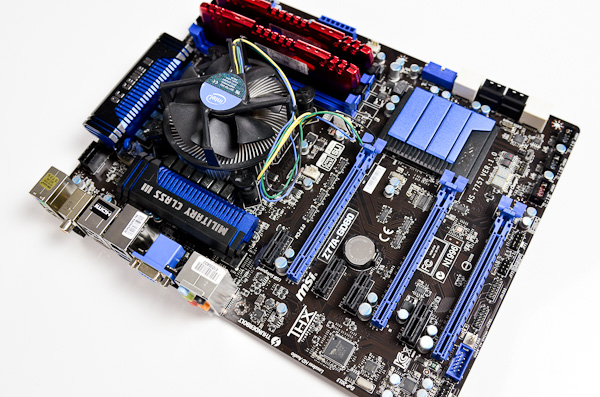
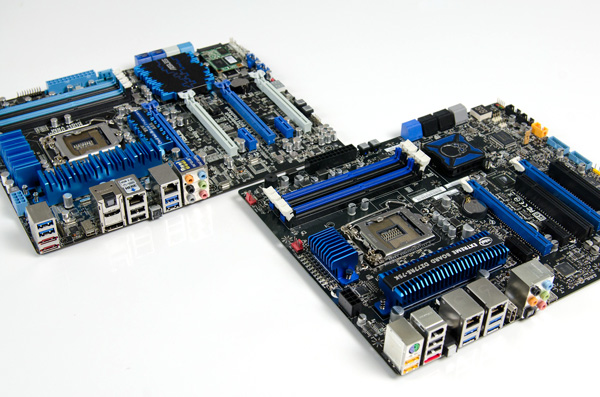

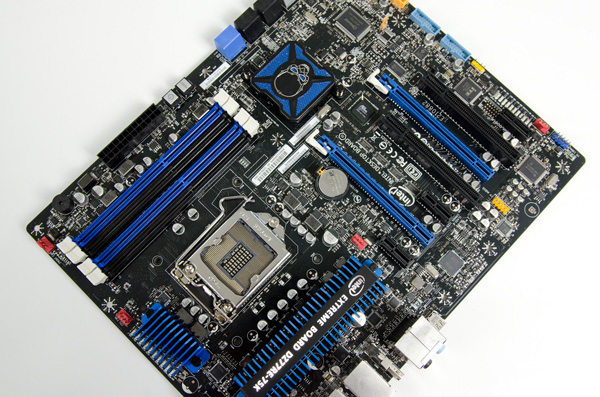
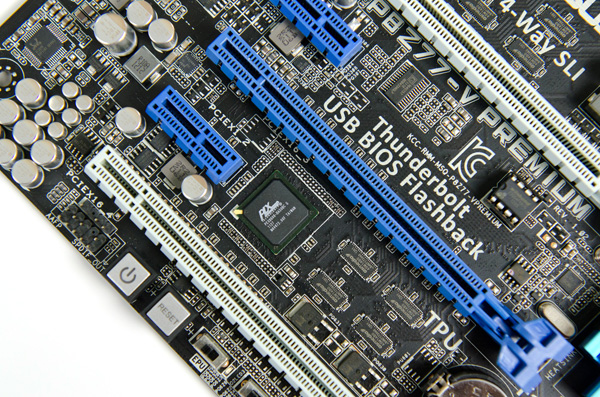
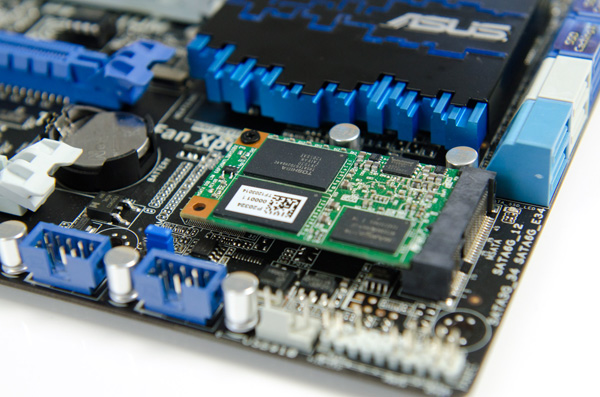
















116 Comments
View All Comments
Jaybus - Monday, June 4, 2012 - link
It was initially designed for use with an optical PHY. Intel's Silicon Photonics lab simply hasn't yet got all of the pieces together. The goal is to have all of the optical components, laser, detector, lenses, and waveguides, on chip. TB is the result of replacing the optical PHY, which is not yet ready, with an electrical PHY. If Intel ever manages the on-chip optics, then it will drastically increase bandwidth while lowering power requirements and heat. Replace TB's electrical PHY with Intel's original intent, and it will drastically outperform USB, or any other electrical interface, without using more power. Also, the on-chip optics would make the optical interface much cheaper to manufacture and the optical cable should be cheaper too, since it wouldn't require the active circuitry.rahvin - Monday, June 4, 2012 - link
You're still going to have an electrical circuit and copper in TB when it goes optical. Otherwise you lose the 10W of bus power it provides. Intel has been very clear that it when it goes optical it is still going to be providing the 10W bus power the spec calls for meaning the copper and electrical will still be there.Jaybus - Wednesday, June 6, 2012 - link
Yes, but just for DC power through the cable. The TB chip doesn't source or regulate the power. The power dissipation for TB chips, electronic or optical, does not include the peripheral power supply, which is the same either way, and also the same for USB 3.derektrotter - Monday, June 4, 2012 - link
I'm with you.I can buy a USB 3.0 SATA dock for much less than the price of a TB cable. And I've been able to do so for a year. And people think somehow the cables will become cheap, but given that there are two CPUs in each one, I don't find that likely.
TB may be better, but USB 3.0 is going to cream it. Really it already has.
It's kinda too bad, I'd love to have one of those TB displays to go with my MacBook Air, but given it won't work with any other device in my house (including my other Mac), that's not going to happen.
Also, that display really should have a USB 3.0 hub in it, not a 2.0 one.
KoolAidMan1 - Sunday, June 3, 2012 - link
Empty Firewire ports are the fault of ignorant users. To this day it is so much better than USB 2.0. If users ignore TB once the technical kinks are hashed out and prices have stabilized, well, I don't know what to sayvectorm12 - Sunday, June 3, 2012 - link
Honestly I was gonna reply about this particular post but once I had finished writing the reply I realized you're either a troll of just incredibly ignorant of other usage-scenarios than your own.In any case I'm not going to dignify that with a detailed reply.
ananduser - Monday, June 4, 2012 - link
"Empty Firewire ports are the fault of ignorant users." What a stupid generalizing statement.Thefinaleofseem - Sunday, June 3, 2012 - link
There never was a 1 year exclusivity arrangement. Sony implemented TB on a laptop last summer. Manufacturers largely weren't interested until it came built into the chipset.repoman27 - Sunday, June 3, 2012 - link
Sony implemented a proprietary interface based on Intel's Light Peak technology. They never called it Thunderbolt because it wasn't. And it still is not built into any chipset. But thanks for playing.Why does every post about Thunderbolt invite a mega troll-a-thon?
ananduser - Monday, June 4, 2012 - link
Why does every TB related post invite Apple users willing to defend the adoption scenarios of the interface. I am skeptical and at the same time honest about TB. I believe that it won't take off and will remain a niche. It is not me who is mega-trolling, but rather some of the macusers commenting here. They feel that it's their duty to defend TB since it was Apple pushed and not because of the technical merits(which I don't dispute).